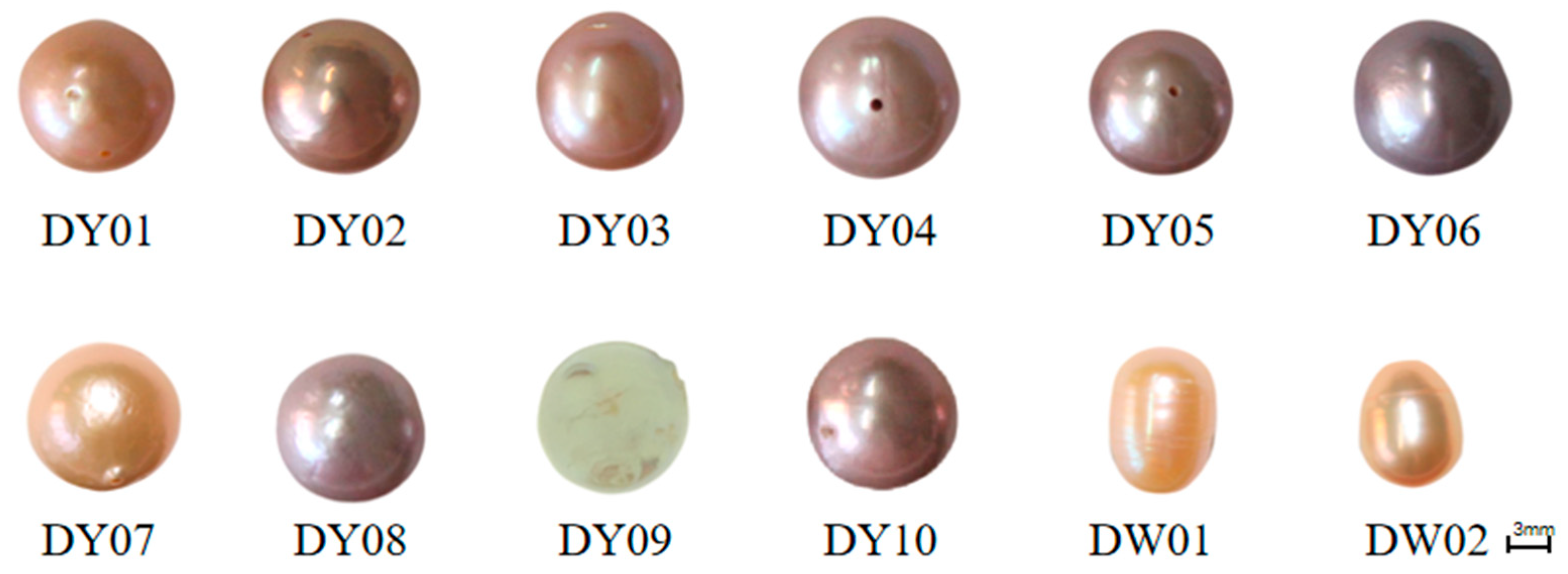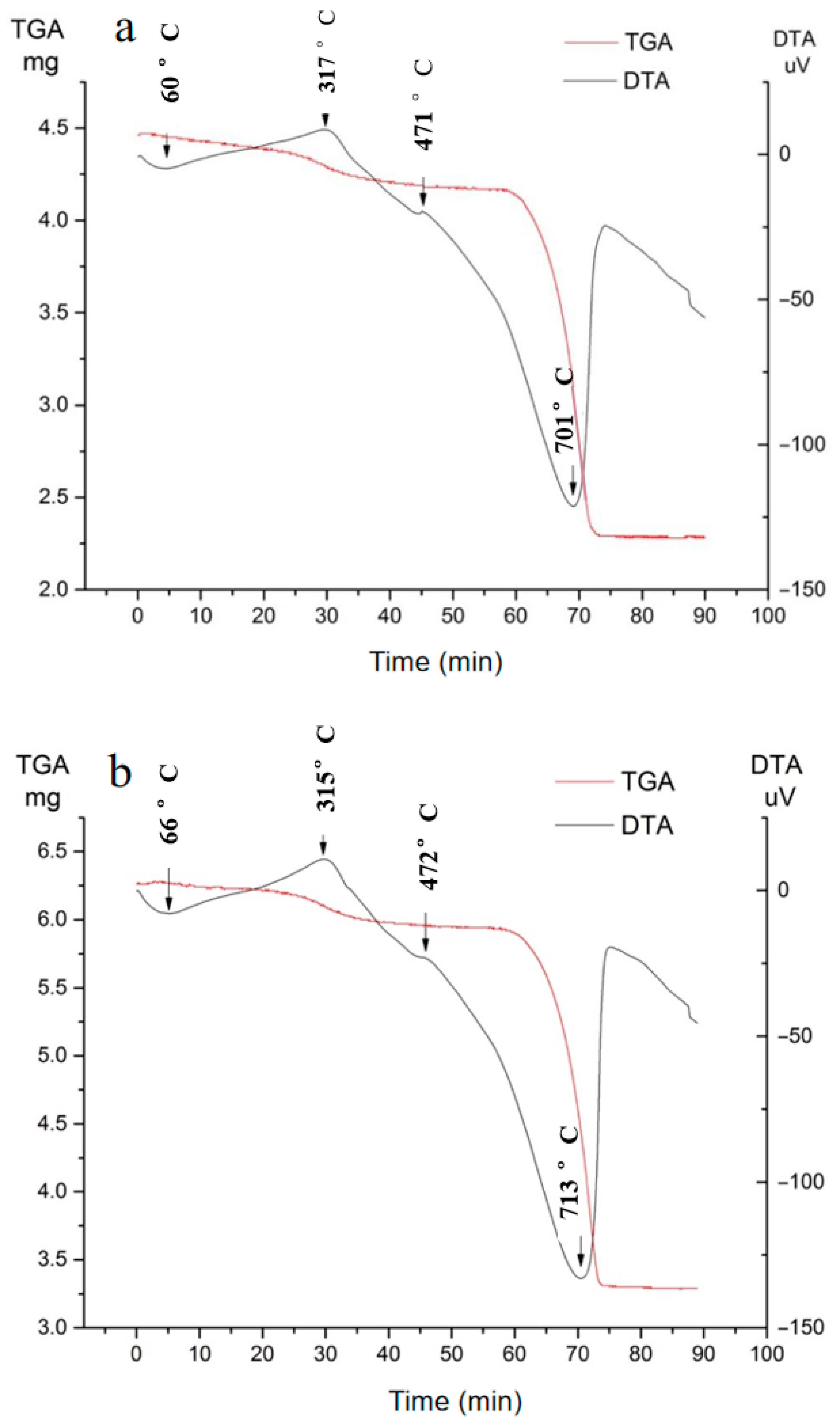Mineral Compositions and Organic Color-Related Compounds of Freshwater Bead-Cultured Pearls from Zhuji, Southeast China: Insights from Multi-Spectroscopic Analyses
Abstract
1. Introduction
2. Sampling and Methods
2.1. Sampling
2.2. Analytical Methods
2.2.1. Fourier Transform Infrared Spectroscopy (FTIR)
2.2.2. Laser Raman Spectroscopy (LRS)
2.2.3. UV-Visible Spectroscopy (UV-Vis)
2.2.4. Cathodoluminescence (CL) Analysis
2.2.5. Micro-Infrared Spectroscopy
2.2.6. Differential Thermal–Thermogravimetric Analysis (TGA-DTA)
3. Results
3.1. Conventional Gemological Characteristics
3.2. FTIR Analysis
3.3. Raman Spectrum Analysis
3.4. UV-Vis Analysis
3.5. Cathodoluminescence Characteristics
3.6. Micro-Infrared Spectral Characteristics
3.7. Differential Thermal–Thermogravimetric Analysis Characteristics
4. Discussion
4.1. Mineral Compositions of FWBCPs
4.2. Color-Causing Mechanisms of FWBCPs
4.3. Comparison of the Properties Between FWBCPs and FWNBCPs
5. Conclusions
Author Contributions
Funding
Data Availability Statement
Acknowledgments
Conflicts of Interest
References
- Karampelas, S.; Fritsch, E.; Makhlooq, F.; Mohamed, F.; Al-Alawi, A. Raman Spectroscopy of Natural and Cultured Pearls and Pearl Producing Mollusc Shells. J. Raman Spectrosc. 2019, 51, 1813–1821. [Google Scholar] [CrossRef]
- Scarratt, K.; Moses, T.M.; Akamatsu, S. Characteristics of Nuclei in Chinese Freshwater Cultured Pearls. Gems Gemol. 2000, 36, 98–109. [Google Scholar] [CrossRef]
- Fiske, D.; Shepherd, J. Continuity and Change in Chinese Freshwater Pearl Culture. Gems Gemol. 2007, 43, 138–145. [Google Scholar] [CrossRef]
- Akamatsu, S.; Zansheng, L.T.; Moses, T.M.; Scarratt, K. The Current Status of Chinese Freshwater Cultured Pearls. Gems Gemol. 2001, 37, 96–113. [Google Scholar] [CrossRef]
- Yang, X.; Zhou, Z.; Qi, X.; Zhang, Z.; Liao, Z. Raman Spectrum Characteristics and Coloration Mechanism of Freshwater-Nucleated Pearls. Laser Optoelectron. Prog. 2021, 58, 2430001. [Google Scholar] [CrossRef]
- Ma, H.Y.; Cui, F. XRD Spectrum of Ball-Shaped Aragonite in Freshwater Pearls. Acta Mineral. Sin. 2003, 23, 371–373. [Google Scholar] [CrossRef]
- Zhang, G.; Li, H. Mineral Composition Characteristics of Freshwater Cultured Pearls. Acta Petrol. Et Mineral. 2004, 23, 89–93. [Google Scholar] [CrossRef]
- Ma, H.Y.; Lee, I.S. Characterization of vaterite in low-quality freshwater cultured pearls. Mater. Sci. Eng. C 2006, 26, 721–723. [Google Scholar] [CrossRef]
- Ma, H.Y.; Su, A.; Zhang, B.L. Vaterite or aragonite is observed in the prismatic layer of freshwater-cultured pearls from south China. Prog. Nat. Sci. 2009, 19, 817–820. [Google Scholar] [CrossRef]
- Soldati, A.L.; Jacob, D.E.; Wehrmeister, U.; Hofmeister, W. Structural characterization and chemical composition of aragonite and vaterite in freshwater cultured pearls. Mineral. Mag. 2008, 72, 579–592. [Google Scholar] [CrossRef]
- Hao, Y.; Zhang, G. In Situ Resonance Raman Spectra of Organic Pigments in Freshwater Cultured Pearls. Spectrosc. Spectr. Anal. 2006, 26, 78–80. [Google Scholar]
- Qin, Z.; Ma, H.; Mu, S.; Tong, Z. Research on Relationship between Color and Raman Spectrum Of Freshwater Cultured Pearl Of Good Quality. Acta Mineral. Sin. 2007, 27, 73–76. [Google Scholar] [CrossRef]
- Shi, L.; Liu, X.; Mao, J.; Han, X. Study of Coloration Mechanism of Cultured Freshwater Pearls from Mollusk Hyriopsis Cumingii. J. Appl. Spectrosc. 2014, 81, 97–101. [Google Scholar] [CrossRef]
- Jiang, Y.; Liu, K.W.; Li, J.; Liu, X.; Shi, A.J. Elemental Analysis and Pharmaceutical Evaluation for Yellow White and Black Pearls of Hyriopsis Cumingii(Lea). Chem. Res. Appl. 2003, 15, 433–434. [Google Scholar]
- Yan, J.; Hu, X.; Wang, J.; Yan, X.; Hu, D. Investigation on the Coloring Mechanism of Freshwater Cultured Pearls with Different Color. Rock Miner. Anal. 2013, 32, 263–268. [Google Scholar]
- Urmos, J.; Sharma, S.; Mackenzie, F. Characterization of Some Biogenic Carbonates with Raman Spectroscopy. Am. Mineral. 1991, 76, 641–646. [Google Scholar]
- Zhang, G.; Xie, X.; Wang, Y. Raman Spectra Of Carotenoid In The Nacre Of Hyriopsis Cumingii (Lea) Shell. Acta Mineral. Sin. 2001, 21, 389–392. [Google Scholar]
- Han, J.W.; Luo, W.; Zheng, D.H.; Zhang, Y.M. The Effect Of Different Concentrations Of β-Carotene On Early Pearl Color And Lustre Degrees In Hyriopsis Cumingii. Oceanol. Et Limnol. Sin. 2011, 56, 9588–9595. [Google Scholar] [CrossRef]
- Hu, Y.; Fan, L.-W.; Huang, Y.-L. Reserach on Raman Spectra of Organic Ingredients on Colored Pearls. Spectrosc. Spectr. Anal. 2014, 34, 98–102. [Google Scholar]
- Soldati, A.L.; Jacob, D.E.; Wehrmeister, U.; Häger, T.; Hofmeister, W. Micro-Raman Spectroscopy of Pigments Contained in Different Calcium Carbonate Polymorphs from Freshwater Cultured Pearls. J. Raman Spectrosc. 2008, 39, 525–536. [Google Scholar] [CrossRef]
- Stupp, S.I. Molecular Manipulation of Microstructures: Biomaterials, Ceramics, and Semiconductors. Science 1997, 277, 1242–1248. [Google Scholar] [CrossRef]
- Huang, C.Y.; Chen, Q.X.; Xiong, Z.Y.; Feng, Y.J.; Li, Y.Q.; Wang, H. Investigation on the Infrared Absorption Spectrum of Pearl and Nacre. Adv. Mater. Res. 2012, 528, 156–159. [Google Scholar] [CrossRef]
- Abduriyim, A. Cultured Pearls from Lake Kasumigaura: Production and Gemological Characteristics. Gems Gemol. 2018, 54, 166–183. [Google Scholar] [CrossRef]
- Xie, S.H. Research on large-scale cultivation technology of fresh water bead cultured pearls. J. Guangdong Ocean. Univ. 2010, 30, 55–58. [Google Scholar]
- Liao, J.; Miao, D.L. Method for Culturing Fresh Water Colored Pearls. China Patent No. CN103210860A, 24 July 2013. [Google Scholar]
- Karampelas, S. Gem News International: Large Natural-Color Freshwater Cultured Pearls with Drilled Beads. Gems Gemol. 2012, 48, 148–149. [Google Scholar]
- Wada, K.; Fujinuki, T. Factors controlling minor elements in pearls. J. Gemmol. Soc. Jpn. 1988, 13, 2–12. [Google Scholar]
- Wehrmeister, U.; Jacob, D.E.; Soldati, A.L.; Häger, T.; Hofmeister, W. Vaterite in Freshwater Cultured Pearls from China and Japan. J. Gemmol. 2007, 30, 399–412. [Google Scholar] [CrossRef]
- Hänni, H.A.; Kiefert, L.; Giese, P. X-Ray Luminescence, a Valuable Test in Pearl Identification. J. Gemmol. 2005, 29, 325–329. [Google Scholar] [CrossRef]
- Kessrapong, P.; Lawanwong, K.; Sturman, N. Pinctada Maculata (Pipi) Bead-Cultured Blister Pearls Attached to Their Shells. GIA Research News. 25 April 2017. Available online: https://www.gia.edu/gia-news-research/pinctada-maculata-bead-cultured-blister-pearls-shells (accessed on 25 April 2017).
- Homkrajae, A.; Sun, Z.; Blodgett, T.; Zhou, C. Provenance Discrimination of Freshwater Pearls by LA-ICP-MS and Linear Discriminant Analysis (LDA). Gems Gemol. 2019, 55, 47–60. [Google Scholar] [CrossRef]
- Sommer, S.E. Cathodoluminescence of Carbonates, 1. Characterization of Cathodoluminescence from Carbonate Solid Solutions. Chem. Geol. 1972, 9, 257–273. [Google Scholar] [CrossRef]
- Götte, T.; Richter, D.K. Quantitative Aspects of Mn-Activated Cathodoluminescence of Natural and Synthetic Aragonite. Sedimentology 2008, 56, 483–492. [Google Scholar] [CrossRef]
- Qiao, L.; Feng, Q.-L. Study on twin stacking faults in vaterite tablets of freshwater lacklustre pearls. J. Cryst. Growth 2007, 304, 253–256. [Google Scholar] [CrossRef]
- Melancon, S.; Fryer, B.J.; Ludsin, S.A.; Gagnon, J.E.; Yang, Z. Effects of Crystal Structure on the Uptake of Metals by Lake Trout (Salvelinus namaycush) Otoliths. Can. J. Fish. Aquat. Sci. 2005, 62, 2609–2619. [Google Scholar] [CrossRef]
- Hasse, B.; Ehrenberg, H.; Marxen, J.C.; Becker, W.; Epple, M. Calcium Carbonate Modifications in the Mineralized Shell of the Freshwater SnailBiomphalaria Glabrata. Chem.-Eur. J. 2000, 6, 3679–3685. [Google Scholar] [CrossRef] [PubMed]
- Zhou, C.; Wing, J.; Shih, S.C.; Tsai, T.-H.; Sun, Z.; Persaud, S.; Qi, L.-J. Detection of Color Treatment and Optical Brightening in Chinese Freshwater “Edison” Pearls. Gems Gemol. 2021, 57, 124–134. [Google Scholar] [CrossRef]
- Hedegaard, C.; Bardeau, J.-F.; Chateigner, D. Molluscan Shell Pigments: An In Situ Resonance Raman Study. J. Molluscan Stud. 2006, 72, 157–162. [Google Scholar] [CrossRef]
- Karampelas, S.; Fritsch, E.; Mevellec, J.-Y.; Gauthier, J.-P.; Sklavounos, S.; Soldatos, T. Determination by Raman Scattering of the Nature of Pigments in Cultured Freshwater Pearls from the Mollusk Hyriopsis Cumingi. J. Raman Spectrosc. 2007, 38, 217–230. [Google Scholar] [CrossRef]
- Karampelas, S.; Fritsch, E.; Mevellec, J.-Y.S.; Soldatos, T. Role of Polyenes in the Coloration of Cultured Freshwater Pearls. Eur. J. Mineral. 2009, 21, 85–97. [Google Scholar] [CrossRef]
- Nilpetploy, N.; Katsurada, Y. Unique Non-Bead Cultured Freshwater Pearls from Lake Biwa, Cultured for 14 Years. Gems Gemol. 2021, 57, 171. [Google Scholar]
- Karampelas, S.; Fritsch, E.; Sklavounos, S.; Soldatos, T. Identification through Raman Scattering of Pigments in Cultured Freshwater Pearls. Gems Gemol. 2006, 42, 99–100. [Google Scholar]
- Sturman, N.; Homkrajae, A.; Manustrong, A.; Somsa-ard, N. Observations on Pearls Reportedly from the Pinnidae Family (Pen Pearls). Gems Gemol. 2014, 50, 202–215. [Google Scholar] [CrossRef]
- Barnard, W.; de Waal, D. Raman Investigation of Pigmentary Molecules in the Molluscan Biogenic Matrix. J. Raman Spectrosc. 2006, 37, 342–352. [Google Scholar] [CrossRef]
- Schügerl, F.B.; Kuzmany, H. Optical modes of trans-polyacetylene. J. Chem. Phys. 1981, 74, 953–958. [Google Scholar] [CrossRef]
- Schaffer, H.E.; Chance, R.R.; Silbey, R.J.; Knoll, K.; Schrock, R.R. Conjugation Length Dependence of Raman Scattering in a Series of Linear Polyenes: Implications for Polyacetylene. J. Chem. Phys. 1991, 94, 4161–4170. [Google Scholar] [CrossRef]
- Homkrajae, A.; Sun, Z. Gemological and Chemical Characteristics of Natural Freshwater Pearls from the Mississippi River System. Gems Gemol. 2019, 55, 278–292. [Google Scholar]
- Nilpetploy, N.; Lawanwong, K.; Kessrapong, P. The Gemological Characteristics of Pipi Pearls Reportedly from Pinctada Maculata. Gems Gemol. 2019, 54, 418–427. [Google Scholar] [CrossRef]
- Karampelas, S. Spectral Characteristics of Natural-Color Saltwater Cultured Pearls from Pinctada Maxima. Gems Gemol. 2012, 48, 193–197. [Google Scholar] [CrossRef]
- Zhou, C.; Wing, J.; Chan, S.; Zhou, J.Y.; Wong, S.D.; Moe, K.S. Identification of “Pistachio” Colored Pearls Treated by Ballerina Pearl Co. Gems Gemol. 2016, 52, 50–59. [Google Scholar] [CrossRef]
- Homkrajae, A.; Sun, Z. Natural Freshwater Pearls from Europe: Russia, Scotland, and Germany. Gems Gemol. 2021, 57, 167–171. [Google Scholar]
- Chen, C.; Yu, J.; Zhang, C.; Ye, X.; Shen, A.H. Nature of Pigments in Orange and Purple Coloured Chinese Freshwater Cultured Pearls: Insights from Experimental Raman Spectroscopy and DFT Calculations. Minerals 2023, 13, 959. [Google Scholar] [CrossRef]
- Karampelas, S.; Michel, J.; Zheng-Cui, M.; Schwarz, J.-O.; Enzmann, F.; Fritsch, E.; Leu, L.; Krzemnicki, M.S. X-Ray Computed Microtomography Applied to Pearls: Methodology, Advantages, and Limitations. Gems Gemol. 2010, 46, 122–127. [Google Scholar] [CrossRef][Green Version]







Disclaimer/Publisher’s Note: The statements, opinions and data contained in all publications are solely those of the individual author(s) and contributor(s) and not of MDPI and/or the editor(s). MDPI and/or the editor(s) disclaim responsibility for any injury to people or property resulting from any ideas, methods, instructions or products referred to in the content. |
© 2025 by the authors. Licensee MDPI, Basel, Switzerland. This article is an open access article distributed under the terms and conditions of the Creative Commons Attribution (CC BY) license (https://creativecommons.org/licenses/by/4.0/).
Share and Cite
Li, X.; Yu, X.-Y.; Zhang, C. Mineral Compositions and Organic Color-Related Compounds of Freshwater Bead-Cultured Pearls from Zhuji, Southeast China: Insights from Multi-Spectroscopic Analyses. Crystals 2025, 15, 824. https://doi.org/10.3390/cryst15090824
Li X, Yu X-Y, Zhang C. Mineral Compositions and Organic Color-Related Compounds of Freshwater Bead-Cultured Pearls from Zhuji, Southeast China: Insights from Multi-Spectroscopic Analyses. Crystals. 2025; 15(9):824. https://doi.org/10.3390/cryst15090824
Chicago/Turabian StyleLi, Xi, Xiao-Yan Yu, and Cun Zhang. 2025. "Mineral Compositions and Organic Color-Related Compounds of Freshwater Bead-Cultured Pearls from Zhuji, Southeast China: Insights from Multi-Spectroscopic Analyses" Crystals 15, no. 9: 824. https://doi.org/10.3390/cryst15090824
APA StyleLi, X., Yu, X.-Y., & Zhang, C. (2025). Mineral Compositions and Organic Color-Related Compounds of Freshwater Bead-Cultured Pearls from Zhuji, Southeast China: Insights from Multi-Spectroscopic Analyses. Crystals, 15(9), 824. https://doi.org/10.3390/cryst15090824







